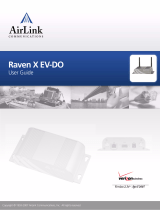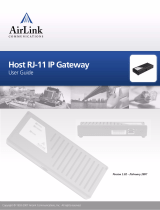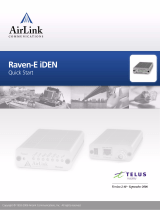Page is loading ...

Raven GPRS
User Guide
AirLink Communications, Inc.
Version 2.01
October 2005

i Cingular GPRS Raven User Guide Version 2.01
Information in this document is subject to change without notice
©Copyright AirLink Communications, Inc., 1993-2005. All rights reserved.
• WARNING
The antenna(s) used for this transmitter must be installed to provide a separation distance of at least 20
cm from all persons and must not be co-located or operating in conjunction with any other antenna or
transmitter.
• Important Notice
Because of the nature of wireless communications, transmission and reception of data can never be guar-
anteed. Data may be delayed, corrupted (i.e., have errors) or be totally lost. Although significant delays
or losses of data are rare when wireless devices such as the AirLink Communications modem are used in
a normal manner with a well-constructed network, the AirLink modem should not be used in situations
where failure to transmit or receive data could result in damage of any kind to the user or any other party,
including but not limited to personal injury, death, or loss of property. AirLink Communications, Inc.,
accepts no responsibility for damages of any kind resulting from delays or errors in data transmitted or
received using the AirLink Communications modem, or for failure of the AirLink Communications
modem to transmit or receive such data.
• Safety and Hazards
Do not operate the AirLink Communications modem in areas where blasting is in progress, where explo-
sive atmospheres may be present, near medical equipment, near life support equipment, or any equip-
ment which may be susceptible to any form of radio interference. In such areas, the AirLink
Communications modem MUST BE POWERED OFF. The AirLink Communications modem can trans-
mit signals that could interfere with this equipment. Do not operate the AirLink Communications
modem in any aircraft, whether the aircraft is on the ground or in flight. In aircraft, the AirLink Commu-
nications modem MUST BE POWERED OFF. When operating, the AirLink Communications modem
can transmit signals that could interfere with various on board systems. The driver or operator of any
vehicle should not operate the AirLink Communications modem while in control of a vehicle. Doing so
will detract from the driver or operator's control and operation of that vehicle. In some states and prov-
inces, operating such communications devices while in control of a vehicle is an offence.
• Limitation of Liability
The information in this manual is subject to change without notice and does not represent a commitment
on the part of AirLink Communications, Inc. AIRLINK COMMUNICATIONS, INC. SPECIFICALLY
DISCLAIMS LIABILITY FOR ANY AND ALL DIRECT, INDIRECT, SPECIAL, GENERAL, INCI-
DENTAL, CONSEQUENTIAL, PUNITIVE OR EXEMPLARY DAMAGES INCLUDING, BUT NOT
LIMITED TO, LOSS OF PROFITS OR REVENUE OR ANTICIPATED PROFITS OR REVENUE
ARISING OUT OF THE USE OR INABILITY TO USE ANY AIRLINK COMMUNICATIONS, INC.
PRODUCT, EVEN IF AIRLINK COMMUNICATIONS, INC. HAS BEEN ADVISED OF THE POS-
SIBILITY OF SUCH DAMAGES OR THEY ARE FORESEEABLE OR FOR CLAIMS BY ANY
THIRD PARTY.

Cingular GPRS Raven User Guide Version 2.01 ii
Contents
CHAPTER 1 Introduction to Raven GPRS 1
Raven Overview 1
Raven face and back 1
GPRS Overview 2
Connecting to Cingular using Serial 2
Establishing a Connection with GPRS 2
Using the Raven to connect to the Internet 3
Using GPRS to Communicate directly to your Device 3
Common Uses for the Raven 4
Financial POS and Kiosk 4
Automation and Telemetry 5
Backup connection to the Internet 5
CHAPTER 2 Subscriber Identity Module (SIM) 7
Installing the SIM 7
Opening the Case 7
Modem back 8

Cingular GPRS Raven User Guide Version 2.01 iii
Modem partially slid from case 8
Ejecting the SIM tray 8
Tray button 8
Empty SIM Tray 9
Inserting the SIM 9
SIM Tray with a SIM 9
Inserting the SIM 9
CHAPTER 3 Raven Activation 10
Connecting the Raven to your computer 10
Quick Start Guide and Setup Wizard 10
Setup Wizard Menu 11
Configuring the Raven using AT Commands 12
Raven Indicator Lights 12
Raven indicator lights 12
CHAPTER 4 Raven Utilities 13
AceView 14
AceView 14
AceView: About Raven 14
Wireless ACE and Wireless ACE Web 15
Wireless ACE 15
AceNet 16
AceNet 16
Modem Doctor 17
Modem Doctor 17
CHAPTER 5 DNS: Using Names Instead of IPs 18
Configuring DNS 18
Wireless ACE: DNS 19
PPP-Peer 19
CHAPTER 6 IP Manager 20
Fully Qualified Domain Name 21

Cingular GPRS Raven User Guide Version 2.01 iv
Dynamic Name Resolution 21
Configuring the Raven for Dynamic IP 22
Wireless ACE: Dynamic IP (IP Manager configuration) 22
Restrictions for Modem Name 23
CHAPTER 7 Keepalive 24
Configuring Keepalive 24
Keepalive Configuration in Wireless ACE 25
Data usage using Keepalive. 25
CHAPTER 8
Host Modes 26
AT Mode 27
PassThru Mode 28
PPP Mode 29
Slip Mode 29
UDP Pad Mode 30
UDP Auto Answer 30
Reliable UDP 31
Multicast UDP 32
TCP PAD Mode 32
TCP Auto Answer 33
Hybrid Modes 33
Hybrid Mode Settings 34
CHAPTER 9 Modbus/BSAP Configuration 35
Modbus Overview 35
Telemetry 36
Remote Terminal Unit (RTU) 36
Supervisory Control and Data Acquisition (SCADA) 36
Programmable Logic Controller (PLC) 36
Modbus TCP/IP 37
Raven Modbus on UDP 37
Automation and Telemetry 37
Configuring the Raven at the Polling Host for Modbus on UDP 38

Cingular GPRS Raven User Guide Version 2.01 v
Port 38
Wireless ACE: Destination Port 38
Wireless ACE: Device Port 38
Default Power-up Mode 38
Wireless ACE: MD Configuration 38
IDs to IPs 39
Wireless ACE: Addr List 39
Dynamic IP 39
Wireless ACE: Modem Name and Domain 40
Configuring the Remote Ravens for Modbus with UDP 40
Port 40
Default Power-up Mode 41
Wireless ACE: UDP Power-up Mode 41
Host Raven IP 41
Wireless ACE: Destination IP 41
Dynamic IPs 41
RTU settings 42
Raven mounted in an enclosure with an RTU 42
RTU to Raven setup 43
Power Connections 43
CHAPTER 10 Simple Network Management Protocol (SNMP) 44
SNMP Overview 44
Management Information Base (MIB) 45
SNMP Traps 45
Raven SNMP Configuration 45
Listening Port 45
Wireless ACE: *SNMPPORT 45
Security Level 46
Wireless ACE: *SNMPPORT 46
User Name and Password 46
Wireless ACE: Changing the Raven Password - Menu Option 47
Wireless ACE: Changing the Raven Password 47
Trap Destination 48
Wireless ACE: *SNMPPORT 48
Example of the MIB trap 48

Cingular GPRS Raven User Guide Version 2.01 vi
CHAPTER 11 Hardware Installation 53
Raven Mounting Kit 53
Raven Mounting Bracket, part number 100-170-1009 A 54
Connecting the Antenna 55
Raven connectors 55
Connecting power 55
Connecting the Raven to a computer or other device 55
CHAPTER 12
AT Commands 57
Using Wireless Ace 57
Wireless ACE: Using AT Commands 57
Wireless ACE: toolbar 58
Using Telnet Terminal Emulation 58
HyperTerminal: Connection Name 58
HyperTerminal: TCP/IP Settings 59
HyperTerminal: AT mode via Telnet 59
Direct Serial Connection 59
HyperTerminal: Connection Name 60
HyperTerminal: Comport Setting 60
HyperTerminal: Comport Settings 60
AT Commands 61
Information and Status 62
Basic Commands 64
Activating (Provisioning) 65
Cellular Network (Cingular GPRS) 67
Local Network and Host Modes 69
PassThru Mode 76
Telnet 77
Friends Mode 77
Time and Date 78
Logging 78
DNS 79
IPManager 80
Keepalive 81
Direct Communication 83
SMTP (email) 85
Modbus Settings 87
89
SNMP 90

Cingular GPRS Raven User Guide Version 2.01 1
CHAPTER 1 Introduction to Raven
GPRS
The AirLink Raven uses serial to connect to a computer or other device and GPRS
to connect to Cingular’s cellular network to allow cellular communication to the
Internet or other network.
Raven Overview
The Raven's rugged form factor is ideal for industrial and commercial applications
that require real-time communications. The Raven provides cellular data communi-
cations for a variety of applications, such as telemetry, public safety, SCADA, traf-
fic control, traffic metering, transit arrival systems and more.
FIGURE 1. Raven face and back

Introduction to Raven GPRS
2 Cingular GPRS Raven User Guide Version 2.01
The Raven has several built in features to make it more effective in a variety of set-
tings. In addition, Airlink provides several modem tools to further enhance the
capabilities of the Raven. These features and tools are introduced in this User
Guide.
• Wireless ACE, Wireless ACE Web, and AceNet
• IPManager
• Modem Doctor
• Keepalive
GPRS Overview
General Packet Radio Service (GPRS) is packet-switched with many users sharing
the same transmission channel, only transmitting when they have data to send. This
means that the total available bandwidth can be immediately dedicated to those
users who are actually sending at any given moment, providing higher utilization
where users only send or receive data intermittently. GPRS provides speeds of 30–
70 kbps with bursts possibly up to 170 kbps.
Connecting to Cingular using Serial
Your Raven is equipped with a serial port which you can use to connect directly to
your computer or device.
If you are using a computer with your Raven you can use Dial-Up Networking
(DUN) to access the Internet or other network applications.
Establishing a Connection with GPRS
Cingular is the Internet Service Provider (ISP) from you to the Internet with the
Raven as the connection to Cingular.

Cingular GPRS Raven User Guide Version 2.01 3
Introduction to Raven GPRS
When your Raven is powered on, it automatically searches for cellular service
using GPRS and establishes a PPP (Point to Point Protocol or “dial” up connection)
link to Cingular’s network. As soon as the Raven receives its IP, it’s ready to create
a TCP/IP network between your computer or device and Cingular’s network so you
can use Cingular to communicate on the Internet.
Using the Raven with a computer or network of computers behind a router using
NAT (Network Address Translation which allows several computers or devices use
a single IP address), you can access the Internet for web browsing, email, FTP, etc.
FIGURE 2. Using the Raven to connect to the Internet
Note: Corporate network connections are unique for each configuration
and not covered as part of the standard installation.
Using GPRS to Communicate directly to your
Device
There are two types of addresses in TCP/IP, dynamic and static.
• Dynamic addresses are assigned on a “need to have” basis. Your Raven might
not always receive the same address each time it connects with Cingular.
• Static addresses are permanently assigned to a particular account and will
always be used whenever your Raven connects to Cingular. The address will
not be given to anyone else.

Introduction to Raven GPRS
4 Cingular GPRS Raven User Guide Version 2.01
If you need to contact the Raven, a device connected to the modem, or a host sys-
tem using the modem, you need to have a known IP (such as one which is static) or
domain name (an IP address which is converted by a DNS server into a word based
name).
Most ISPs (cellular included) use dynamic IP addresses rather than static IP
addresses. A dynamic IP address is suitable for many common Internet uses, such
as web browsing, looking up data on another computer system, or other client func-
tion (such as data only being sent out or only being received after an initial request).
If you have a dynamic IP address for your Raven, you can use a service (such as IP
Manager, covered later in this User Guide) to translate a dynamic IP address to a
fully qualified domain name so you can contact the Raven as if it had a static IP.
Common Uses for the Raven
The Raven’s rugged construction and cellular connection make it ideal for use in
remote and/or industrial locations. The Raven can be used for telemetry and for
more advanced communication to the device or devices behind it.
FIGURE 3. Financial POS and Kiosk

Cingular GPRS Raven User Guide Version 2.01 5
Introduction to Raven GPRS
FIGURE 4. Automation and Telemetry
FIGURE 5. Backup connection to the Internet

Introduction to Raven GPRS
6 Cingular GPRS Raven User Guide Version 2.01

Cingular GPRS Raven User Guide Version 2.01 7
CHAPTER 2 Subscriber Identity
Module (SIM)
The Subscriber Identity Module (SIM) in the Raven is a smartcard securely storing
the key identifying a mobile subscriber. Generally, you will only need to install the
SIM once in the life of the modem and it may be pre-installed by Cingular or Air-
Link.
Installing the SIM
To install the SIM, you will only need a small phillips head screw driver.
Opening the Case
1. Unplug the modem power and all cables.
2. Using a small phillips head screw driver, remove the two screws on the back of
the modem.

Subscriber Identity Module (SIM)
8 Cingular GPRS Raven User Guide Version 2.01
FIGURE 1. Modem back
3. Slide the casing off of the modem and set it aside.
FIGURE 2. Modem partially slid from case
Ejecting the SIM tray
4. Using the tip of a closed pen, a paper clip, or PDA stylus, press the yellow but-
ton between the two cards.
FIGURE 3. Tray button

Cingular GPRS Raven User Guide Version 2.01 9
Subscriber Identity Module (SIM)
5. Slide the tray out of the slot.
FIGURE 4. Empty SIM Tray
Inserting the SIM
6. Place the SIM into the tray and gently press to click it into place.
FIGURE 5. SIM Tray with a SIM
7. Slide the tray back into the modem and gently press to click it into place.
FIGURE 6. Inserting the SIM
8. Slide the modem back into the case.
9. Secure the back of the modem with the screws.

Cingular GPRS Raven User Guide Version 2.01 10
CHAPTER 3 Raven Activation
Your Raven needs specific parameters before it can operate on the Cingular GPRS
network. Cingular will provide you with the necessary parameters to get the Raven
configured.
Connecting the Raven to your computer
Your Raven’s serial port can be connected directly to most computers or devices
using a standard straight through serial cable.
Quick Start Guide and Setup Wizard
The preferred way to configure and activate your Raven is via the AirLink Setup
Wizard for Cingular GPRS. The Quick Start Guide will lead you through the using
the Setup Wizard.
• The Cingular GPRS Raven Setup Wizard is available from the AirLink web
site, http://www.airlink.com/support.

Cingular GPRS Raven User Guide Version 2.01 11
Raven Activation
• The Cingular GPRS Raven Quick Start Guide is also available at the AirLink
web site.
Note: The web site may have a more recent Setup Wizard and Quick
Start Guide than those included with your Raven. It is recommended that
you check with the web site for the latest version before installing your
Raven.
To run the Setup Wizard, you will need Microsoft Windows 98, Windows 2000,
Windows XP, or later and .Net enabled.
1. Select Start
2. Select All Programs
3. Select AirLink Communications
4. Select Setup Wizard
5. Select Setup Wizard
FIGURE 1. Setup Wizard Menu
The Cingular GPRS Raven Quick Start Guide specifies the information you need
and will lead you through the steps.

Raven Activation
12 Cingular GPRS Raven User Guide Version 2.01
Configuring the Raven using AT Commands
An alternate method to configure and activate your Raven is by AT commands (full
listing beginning on page 61) sent directly to the modem via a terminal application
(page 58). This method is recommended only in situations where the Setup Wizard
is not available and/or the configuration for the Raven is unusual.You can also con-
figure your modem using Wireless ACE (page 15) or AceNet (page 16) using a
template built in Wireless ACE. It is not recommended to activate a modem using
either Wireless ACE or AceNet.
Raven Indicator Lights
When your Raven is connected to power and an antenna, there is a specific pattern
to the lights to indicate its operation mode.
FIGURE 2. Raven indicator lights
Tx (transmit) and Rx (receive) - Lights will flash as data is transferred to and
from the modem on the network.
RSSI - Light shows the strength of the signal and may be solid (strong) or flash-
ing (weaker).
Reg - Indicates the modem is registered (activated) on the cellular network.
Chan and Link - Indicate a connection to the cellular network.
Pwr - Indicates the power adapter is connected and there is power getting to the
modem.
/





